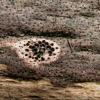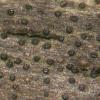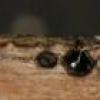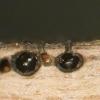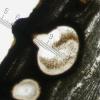
06-12-2025 00:19
 Viktorie Halasu
Viktorie Halasu
Hello, would anyone have this article, please? An

05-12-2025 17:33
 Bruno Coué
Bruno Coué
Bonjour, je serais heureux de recueillir votre avi

02-12-2025 18:59
This pair of ascos 2.5cm across were on recently b

02-12-2025 19:25
Buckwheat PeteHello, can anyone identify this hairy fungus growi

30-11-2025 12:53
 Edvin Johannesen
Edvin Johannesen
White short-stipitate apothecia found on thin twig

30-11-2025 10:47
 William Slosse
William Slosse
I recently found a collection of small Peziza sp.
Related to the thread of Daniel Ghysenlinck I know put data about my unidentified Eutypa collections which were made on Fagus sylvatica.
Description: Fruitbodies very inconspicuous, from some distance only a darkening of the wood. With the naked eye the ostioles could just be seen as tiny black dots on the blackish surface. The Stroma with the scattered perithecia is about 0.5 - 0.6 mm thick. Perithecia are about 0.4 mm broad and 0.3 mm high with a neck length of about 0.25 mm. About 0.15 mm of the neck is within the stroma and only some 0.1 mm protruding as a semiglobous structure (see photos).
Microscopy: Asci are typically long stalked with a spore bearing part of about 25-35 micrometers. Apical apparatus is very faintly and inconspicuously bluish in Iodine. Spores are brownish, allantoid and 6-9 x 1.8-2.2 micrometers with 7 x 2 beeing the average.
Ideas are very welcome. Ask if you need further morphological details.
Thanks very much
Stefan

I have not checked microscopic characters, but why not consider Diatrype decorticata ?
Yannick
This seems to be a good idea to follow. Thanks for the Input!
Stefan
Alain

I think Alain is right.
Yannick
This is definitly a name I came by during my researches. Can't remember why I discarded it again. Probably because there is little illustration and documentation on the species. But I will definitly focus on this now and compare characters with literature about E. lata.
Thanks again
Stefan
